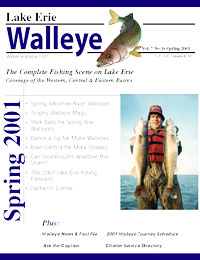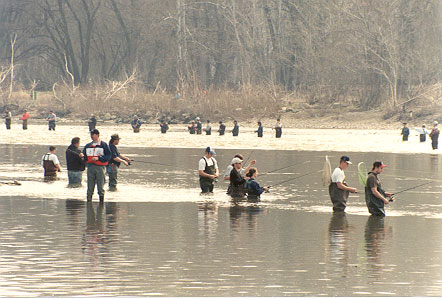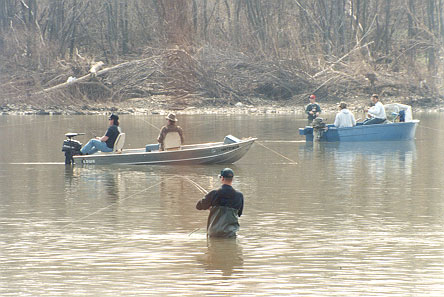Spring Run Maumee River Walleyes
by Scott Carpenter

Order Lake Erie Walleye Magazine
Three Information-Packed Issues for only $10.00
Delivered to your doorstep every March, June and September
|
Spring Run Maumee River Walleyes |
|
T
hereís a pretty good crowd for a Wednesday afternoon at Daleís, a "Cheers"-like sports bar next to City Hall in Maumee,
Ohio. Daleís is the kind of place where everyone might know your name, but
today almost everyone is from out of town.
City Hall in Maumee,
Ohio. Daleís is the kind of place where everyone might know your name, but
today almost everyone is from out of town.
Thatís because Daleís is also the kind of place a fisherman longs for after standing all morning waste deep in the 50-degree water of the Maumee River, which is what about 400 people were doing just up the road earlier on this nippy April day.
When itís Spring Run time on the muddy Maumee up to 50,000 people, maybe more, arrive in this busy Toledo suburb to participate in a seasonal ritual unparalleled on the Great Lakes.
Between late March and mid-April the Maumee swells from snowmelt and rain, opening the way for a half-million walleye to swim upriver to spread their eggs among the protective gravel and cobblestone just below the Fallen Timbers Rapids.
Not surprisingly, thatís exactly where youíll find the fishermen wading and waiting, rods clenched in their hands, landing nets tucked in the back of their waders. After a few hours of standing on the small rocks in the cool, moving water, perhaps catching a fish or two - maybe even a limit - the fishermen get tired and hungry and head for a place like Daleís. Itís the natural order of things.
To the uninitiated, the Spring Run is a strange spectacle. On West River Road, a scenic drive through Side Cut Metropark, vendors hawk jigs made of lead balls attached to hooks with colorful plastic tails. Cars ó mostly trucks, actually ó line both sides of the road, the overflow spilling into the surrounding neighborhoods. Bystanders stop to gawk at the anglers spaced an armís length apart in each direction.
Early walleye are typically caught after the first of March, with the spawn generally peaking in early April and tapering off by the end of the month. White bass then move into the river to spawn in May.
Last year, temperatures in the mid- and upper-70s warmed the low river early. As of March 10, it was already 54 degrees. By then, dozens of anglers were already easily crossing to Blue Grass Island, where they were catching the first of the fish to move up the river. Then came the sleet and snow to cool things off a bit. This sort of start, stop, start pattern is common during the spring run
because of the ever-changing nature of spring in northwest Ohio.
Most spring run walleye anglers wade into the river and cast upstream using
lead-head jigs with colored twister-tail bodies.  Some cast from shore and still
others fish from boats further downstream.
Some cast from shore and still
others fish from boats further downstream.
A large crop of fish in the desirable 18- to 20-inch range moved into the river early last season. Then the water level dropped, concentrating the fish and affording easy access for fishermen. Add perfect weather with 70-degree temperatures, throw in a holiday weekend and we had the recipe for a banner year for the Spring Run. Limit catches of 10 fish per day were not uncommon.
New regulations in Ohio this year, however, will take a bite out of the daily bag limit. For the first time, the Ohio Division of Wildlife has proposed a split season, with a limit of four walleye per day in March and April and six fish per day May through February.
The new limits are among "more cautious walleye harvest strategies," said Mike Budzik, chief of the Ohio Division of Wildlife. The state is working with other agencies in Ohio and Ontario to strengthen Lake Erieís declining walleye stocks. "Although fishing for smallmouth bass and yellow perch has been good, we need to do our part to improve walleye fishing ó which made our lake so popular in the 1980s and í90s," Budzik said. For its part, Ontario has proposed significant cuts in the commercial walleye harvest north of the border.
Walleye "run" in practically every Lake Erie tributary. The Detroit, Sandusky, Portage, Huron and Vermilion rivers in northern Ohio and southern Michigan all have runs of varying sizes. But none compares to the Maumee for the number of fish or the hours that fishermen spend pursuing them.
"There really isnít another walleye fishery that rivals the Maumee," said Roger Knight, a fisheries biologist at the Ohio Division of Wildlifeís Lake Erie Research Station in Sandusky.
The estimated 400,000 to 500,000 walleye a year that crowd into the river is a tiny fraction of the estimated 60 million walleye in Lake Erie. But because each female broadcasts hundreds of thousands of eggs, the run is an important part of the Lake Erie "fish factory."
Ongoing research in Ohio is attempting to use DNA marking to identify fish that come from specific spawning grounds. Such information would allow the state to manage specific locations to maximize fish productions.
One reason Lake Erie is the Walleye Capital of the World is that two very different spawning habitats contribute to the population: the rivers and the reefs on the open lake. Each stocks a large number of fish and can make up for the other if one has a poor production year.
The Maumee River has one of the worldís largest river spawning populations of walleye ó "definitely the largest on Lake Erie," Knight said. Historically, however, the Sandusky River near Fremont may have been even larger. Building the Ballville Dam in the 1920s and extensive channeling and shore changes in the 1970s have dramatically reduced the spawning habitat on the Sandusky. In recent years, researchers have taken walleye from below and relocated them above the dam and proved that the upriver section is still viable spawning habitat. The Division of Wildlife is now working on a plan to remove the dam, opening an additional eight river miles of spawning ground. If that happens - and depending on who you ask it may happen next year or not at all - the additional habitat could also benefit white bass and even lake sturgeon, two other river spawning species. Not to mention adding much needed access for anglers.
"Itís a very rare opportunity to do something that could have a huge impact," Knight said. "As a biologist, youíre lucky if an opportunity like this comes along once in a career."
If the crowds on the Maumee River are any indication, the additional opportunity to catch walleye would be greatly appreciated.
Each year, anglers spend between 36,000 and 250,000 hours fishing on the Maumee during the Spring Run, said Doug Johnson, a fisheries biologist who oversees creel surveys for the Division of Wildlife. On the Sandusky River, "angler hours" range from 24,000 to 94,000 a year.
If the average angler spends three to three and one-half hours on each fishing trip, that means in peak years, such as 1990 when the quarter-million hours were logged on the Maumee, as many as 72,000 to 83,000 fishermen participate in the Spring Run. Those fishermen catch just 10 percent of the fish that make their way up the river to spawn ó on average about 40,000 to 50,000 fish per year.
In 1999, it appeared the number of fishermen on the Maumee would be the highest in a decade. Then water levels rose with the spring rains, making it too difficult to wade. But it was fun while it lasted, and there will be another Spring Run next year. The fish and the fishermen always come back - and Daleís is always glad they came.
Fishing at Side Cut Metropark
Side Cut Metropark is located on River Road between Ford Street and Jerome Road in Maumee. From I-475, follow US 24 west and exit at Jerome Road. Normal Metropark hours are 7 a.m. until dark every day. However, Side Cut is open for fishing from sunrise to sunset March 1 through May 1 to coincide with the stateís legal fishing hours for the season. Access to Blue Grass Island is controlled and signs are posted when the danger of crossing is increased because of high water. The Metroparks provides updated information on river conditions and the status of the run on its website at www.metroparkstoledo.com and on the Walleye Line at 419-893-9740.
Scott Carpenter is a freelance writer from Toledo and a public information officer for Toledo Metroparks. His new book, "Lake Erie Journal: Guide
to the Official Lake Erie Circle Tour," will be published this spring by Big River Press (www.lakeeriebooks.com)